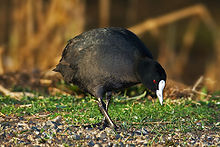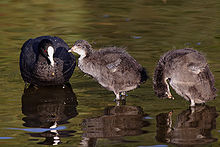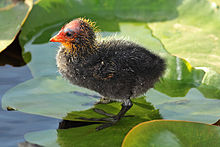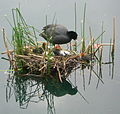- Eurasian Coot
-
Eurasian Coot 
Feeding in Tasmania, Australia Conservation status Scientific classification Kingdom: Animalia Phylum: Chordata Class: Aves Order: Gruiformes Family: Rallidae Genus: Fulica Species: F. atra Binomial name Fulica atra
Linnaeus, 1758Synonyms - Fulica prior De Vis, 1888[2]
The Eurasian Coot, Fulica atra, also known as Coot, is a member of the rail and crake bird family, the Rallidae. The Australian subspecies is known as the Australian Coot.
Contents
Distribution
The Coot breeds across much of the Old World on freshwater lakes and ponds. It occurs and breeds in Europe, Asia, Australia, and Africa. The species has recently expanded its range into New Zealand. It is resident in the milder parts of its range, but migrates further south and west from much of Asia in winter as the waters freeze.
Description
The Coot is 32–42 cm (13–17 in) long and weighs 585–1,100 g (1.29–2.4 lb), and is largely black except for the white facial shield (which gave rise to the phrase "as bald as a coot", which the Oxford English Dictionary cites in use as early as 1430).[3] As a swimming species, the Coot has partial webbing on its long strong toes.
The juvenile is paler than the adult, has a whitish breast, and lacks the facial shield; the adult black plumage develops when about 3–4 months old, but the white shield is only fully developed at about one year old.
This is a noisy bird with a wide repertoire of crackling, explosive, or trumpeting calls, often given at night.
Behaviour
The Coot is much less secretive than most of the rail family, and can be seen swimming on open water or walking across waterside grasslands. It is an aggressive species, and strongly territorial during the breeding season, and both parents are involved in territorial defence.[4] During the non-breeding season they may form large flocks, possibly related to predator avoidance.[5]
It is reluctant to fly and when taking off runs across the water surface with much splashing. They do the same, but without actually flying, when travelling a short distance at speed in territorial disputes. As with many rails, its weak flight does not inspire confidence, but on migration, usually at night, it can cover surprisingly large distances. It bobs its head as it swims, and makes short dives from a little jump.
Breeding
This species builds a nest of dead reeds or grasses, but also pieces of paper or plastic near the water's edge or on underwater obstacles protruding from the water, laying up to 10 eggs, sometimes 2 or 3 times per season. Usually only a few young survive. They are frequent prey for birds such as herons and gulls.
Coots can be very brutal to their own young under pressure such as the lack of food. They will bite young that are begging for food and repeatedly do this until it stops begging and starves to death. If the begging continues, they may bite so hard that the chick is killed.[6]
Diet
The Coot is an omnivore, and will take a variety of small live prey including the eggs of other water birds, as well as algae, vegetation, seeds and fruit.[7] It shows considerable variation in its feeding techniques, grazing on land or in the water. In the water it may upend in the fashion of a Mallard or dive in search of food.[8]
Status
The Eurasian Coot is one of the species to which the Agreement on the Conservation of African-Eurasian Migratory Waterbirds (AEWA) applies.
Gallery
References
- ^ BirdLife International (2004). Fulica atra. 2006. IUCN Red List of Threatened Species. IUCN 2006. www.iucnredlist.org. Retrieved on 10 May 2006. Database entry includes justification for why this species is of least concern.
- ^ Condon, H. T. (1975) Checklist of the Birds of Australia: Non-Passerines Royal Australasian Ornithologists Union, 57:311
- ^ CRC Handbook of Avian Body Masses by John B. Dunning Jr. (Editor). CRC Press (1992), ISBN 978-0849342585.
- ^ Cave,A.J.; J.Visser; A.C. Perdeck. (1989). "Size and quality of the Coot (Fulica atra) territory in relation to age of its tenants and neighbours". Ardea 77: 87 - 97
- ^ van den Hout PJ (2006) "Dense foraging flotillas of Eurasian coots Fulica atra explained by predation by Ganges soft-shell turtle Aspideretus gangeticus?". Ardea 94 (2): 271-274
- ^ Attenborough, David (1998 Episode 9, 12 mins ff.). The Life of Birds. Princeton: Princeton University Press. ISBN 9780691016337.
- ^ Martin R. Perrow, J. Hans Schutten, John R. Howes, Tim Holzer, F. Jane Madgwick and Adrian J. D. Jowitt (1997) "Interactions between coot (Fulica atra) and submerged macrophytes: the role of birds in the restoration process". Hydrobiologia 342/343: 241–255 doi:10.1023/A:1017007911190
- ^ Brigitte J. Bakker and Robin A. Fordham (1993) "Diving behaviour of the Australian Coot in a New Zealand lake". Notornis 40 (2): 131–136
External links
- Eurasian Coot videos, photos & sounds on the Internet Bird Collection
- Ageing and sexing (PDF) by Javier Blasco-Zumeta
Categories:- IUCN Red List least concern species
- Fulica
- Birds of Europe
- Birds of Iceland
- Birds of Lithuania
- Birds of New Zealand
- Birds of Pakistan
- Birds of South Australia
- Birds of Southeast Asia
- Birds of Tasmania
- Birds of Thailand
- Birds of Turkey
- Birds of Western Australia
- British Isles coastal fauna
Wikimedia Foundation. 2010.








